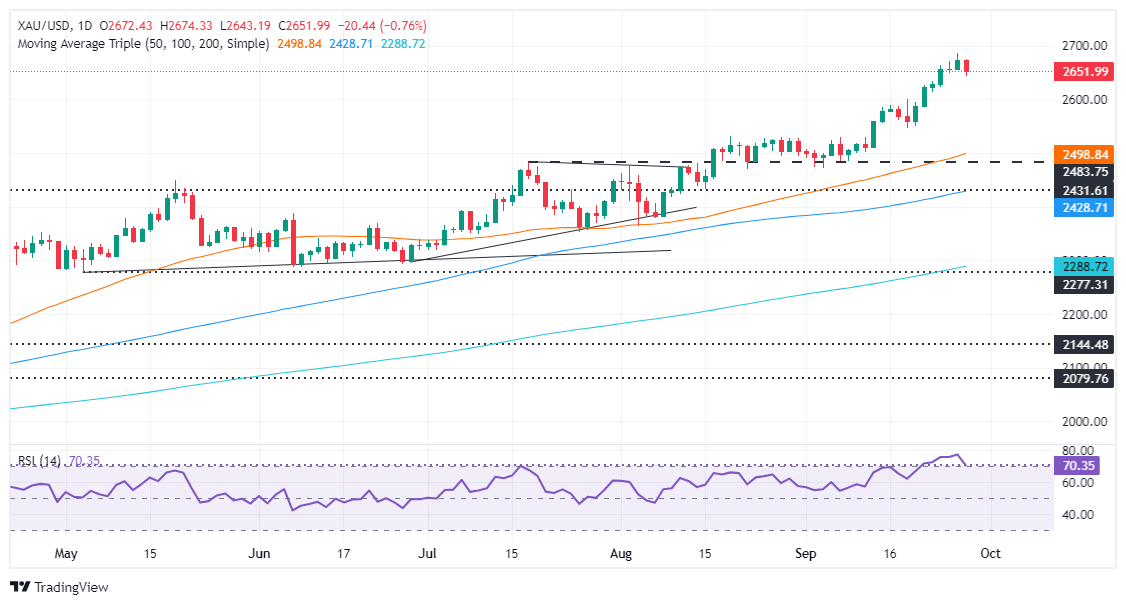- XAU/USD drops to $2,646 after September inflation data suggests progress toward the Fed’s 2% target.
- US 10-year Treasury yield falls five basis points, while the US Dollar Index dips by 0.16% to 100.41.
- Geopolitical risks rise as Israel strikes Lebanon, but Gold fails to gain momentum as traders cash in profits.
Gold fell to a three-day low beneath $2,650 after the US Bureau of Economic Analysis (BEA) revealed that September inflation continued to evolve toward the Federal Reserve’s (Fed) goal. Even though this warranted further easing by the Fed, the golden metal failed to gain traction as analysts speculated that traders were booking profits. The XAU/USD trades at $2,657, down by almost 0.50%.
Earlier, the BEA revealed that the Fed’s preferred inflation gauge, the Personal Consumption Expenditures Price Index (PCE), is slightly closer to the central bank’s 2% target, according to August’s data. Meanwhile, core PCE increased by a tenth of a percentage point compared to July’s data.
Following the data, the US 10-year Treasury note yield fell five basis points to 3.749%. Consequently, the Greenback dropped as the US Dollar Index (DXY) slumped 0.16% to 100.41.
After the data, the odds of 50 basis points (bps) of easing at the November meeting increased, according to the CME FedWatch Tool.
Given the market’s reaction, it was expected that Gold prices might be set for another record high. Nevertheless, the XAU/USD plummeted below the September 26 daily low of $2,654, opening the door for a deeper pullback.
Other data revealed that the University of Michigan Consumer Sentiment for September improved in its final reading.
Aside from this, an escalation in the Middle East conflict between Israel and Hezbollah looms. Israel claimed that it hit Hezbollah’s main headquarters in southern Beirut on Friday.An Israeli official said the government hopes not to proceed with a ground invasion of Lebanon but would not rule it out.
Reuters revealed that Gold ETFs saw modest net inflows last week and have yet to fully contribute to Gold’s rally, though analysts expect more activity from ETFs in coming months.
Daily digest market movers: Gold price tumbles as US inflation approaches 2% goal
- August US PCE came in at 2.2% YoY, down from 2.5% a month earlier and slightly lower than the consensus estimate.
- Core PCE increased modestly as expected from 2.6% to 2.7% YoY for the same period.
- The University of Michigan (UoM) Consumer Sentiment for September improved from 69.0 to 70.1. Inflation expectations for one year dipped from 2.8% to 2.7%, while five-year expectations rose from 3% to 3.1%.
- Market participants have fully priced in at least a 25 bps rate cut by the Fed. However, the odds of a 50 bps cut have decreased to 54.7%, down from a 60% chance two days ago, according to the CME FedWatch Tool.
XAU/USD technical analysis: Gold price slumps and hovers around $2,650
Gold price hit an all-time high of $2,685 and remains upwardly biased. However, buyers were unable to hit new record highs, opening the door for a pullback. Short-term momentum favors sellers as the Relative Strength Index (RSI) exits from overbought territory, aiming toward the 60 mark.
If XAU/USD drops below $2,650, look for a test of the September 18 daily high at $2,600. The following key support levels to test will be the September 18 low of $2,546, followed by the 50-day Simple Moving Average (SMA) at $2,488.
Conversely, If XAU/USD extends its rally past the current year-to-date (YTD) peak of $2,685, the next resistance would be the $2,700 mark. Up next would be the $2,750 level, followed by $2,800.
Gold FAQs
Gold has played a key role in human’s history as it has been widely used as a store of value and medium of exchange. Currently, apart from its shine and usage for jewelry, the precious metal is widely seen as a safe-haven asset, meaning that it is considered a good investment during turbulent times. Gold is also widely seen as a hedge against inflation and against depreciating currencies as it doesn’t rely on any specific issuer or government.
Central banks are the biggest Gold holders. In their aim to support their currencies in turbulent times, central banks tend to diversify their reserves and buy Gold to improve the perceived strength of the economy and the currency. High Gold reserves can be a source of trust for a country’s solvency. Central banks added 1,136 tonnes of Gold worth around $70 billion to their reserves in 2022, according to data from the World Gold Council. This is the highest yearly purchase since records began. Central banks from emerging economies such as China, India and Turkey are quickly increasing their Gold reserves.
Gold has an inverse correlation with the US Dollar and US Treasuries, which are both major reserve and safe-haven assets. When the Dollar depreciates, Gold tends to rise, enabling investors and central banks to diversify their assets in turbulent times. Gold is also inversely correlated with risk assets. A rally in the stock market tends to weaken Gold price, while sell-offs in riskier markets tend to favor the precious metal.
The price can move due to a wide range of factors. Geopolitical instability or fears of a deep recession can quickly make Gold price escalate due to its safe-haven status. As a yield-less asset, Gold tends to rise with lower interest rates, while higher cost of money usually weighs down on the yellow metal. Still, most moves depend on how the US Dollar (USD) behaves as the asset is priced in dollars (XAU/USD). A strong Dollar tends to keep the price of Gold controlled, whereas a weaker Dollar is likely to push Gold prices up.


 This “NEW CONCEPT” Trading Strategy Prints Money!… (INSANE Results!)
This “NEW CONCEPT” Trading Strategy Prints Money!… (INSANE Results!)